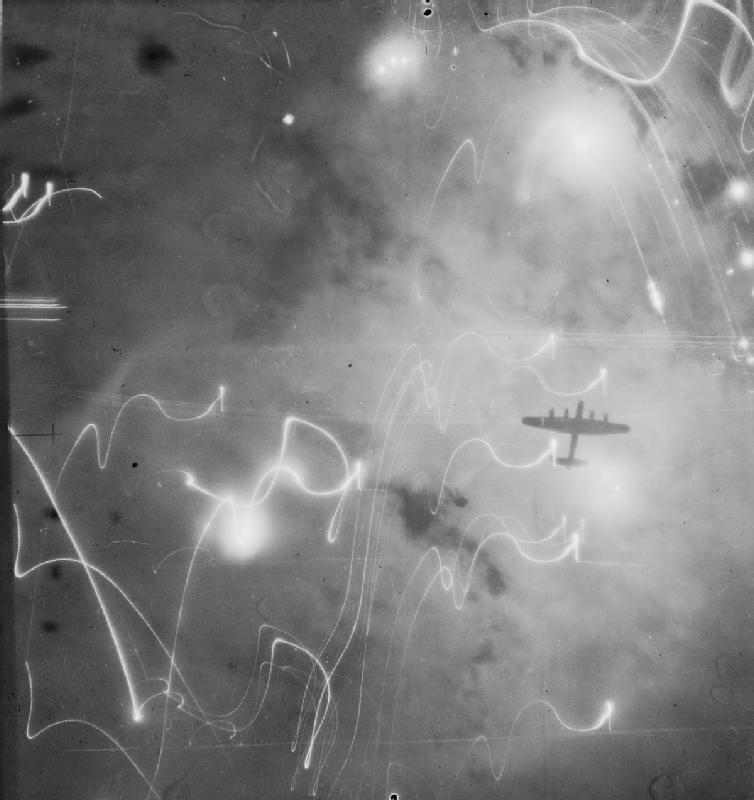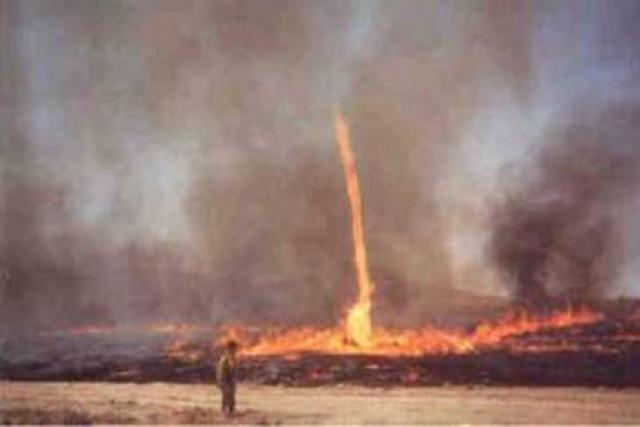|
Firestorm
A firestorm is a conflagration which attains such intensity that it creates and sustains its own wind system. It is most commonly a natural phenomenon, created during some of the largest bushfires and wildfires. Although the term has been used to describe certain large fires, the phenomenon's determining characteristic is a fire with its own storm-force winds from every point of the compass towards the storm's center, where the air is heated and then ascends. The Black Saturday bushfires, the 2021 British Columbia wildfires, and the Great Peshtigo Fire are possible examples of forest fires with some portion of combustion due to a firestorm, as is the Great Hinckley Fire. Firestorms have also occurred in cities, usually due to targeted explosives, such as in the aerial firebombings of London, Hamburg, Dresden, and Tokyo, and the atomic bombing of Hiroshima. Mechanism A firestorm is created as a result of the stack effect as the heat of the original fire draws in mor ... [...More Info...] [...Related Items...] OR: [Wikipedia] [Google] [Baidu] |
Conflagration
A conflagration is a large fire in the built environment that spreads via structure to structure ignition due to radiant or convective heat, or ember transmission. Conflagrations often damage human life, animal life, health, and/or property. A conflagration can begin Fire prevention, accidentally or be intentionally created (arson). A very large fire can produce a firestorm, in which the central column of rising heated air induces strong inward winds, which supply oxygen to the fire. Conflagrations can cause Casualty (person), casualties including deaths or injuries from burns, collapse of structures and attempts to escape, and smoke inhalation. Firefighting is the practice of extinguishing a conflagration, protecting life and property and minimizing damage and injury. One of the goals of fire prevention is to avoid conflagrations. When a conflagration is extinguished, there is often a fire investigation to determine the cause of the fire. Causes and types During a conflagrati ... [...More Info...] [...Related Items...] OR: [Wikipedia] [Google] [Baidu] |
Peshtigo Fire
The Peshtigo fire was a large forest fire on October 8, 1871, in northeastern Wisconsin, United States, including much of the southern half of the Door Peninsula and adjacent parts of the Upper Peninsula of Michigan. The largest community in the affected area was Peshtigo, Wisconsin, which had a population of approximately 1,700 residents. The fire burned about and is the deadliest wildfire in recorded history, with the number of deaths estimated between 1,500 and 2,500. The exact number of deaths is debated. Data from mass graves, both those already exhumed and those still being discovered, show that the death toll of the blaze was most likely greater than the 1889 Johnstown flood death toll of 2,200 people or more. Occurring on the same day as the more famous Great Chicago Fire, the Peshtigo fire has been largely forgotten, even though it killed at least five times as many people. Nonetheless, several cities in Michigan, including Holland and Manistee (across Lake Mic ... [...More Info...] [...Related Items...] OR: [Wikipedia] [Google] [Baidu] |
Great Hinckley Fire
The Great Hinckley Fire was a conflagration in the pine forests of the U.S. state of Minnesota in September 1894, which burned an area of at least (perhaps more than ), including the town of Hinckley. The official death count was 418; the actual number of fatalities was likely higher. Other sources put the death toll at 476.Headlines and Heros. A Treasury of Railroad Folklore. New York, Bonaza Books, 1953 Description After a two-month summer drought, combined with very high temperatures, several small fires started in the pine forests of Pine County, Minnesota. The fires' spread apparently was due to the then-common method of lumber harvesting, wherein trees were stripped of their branches in place; these branches littered the ground with flammable debris. Also contributing was a temperature inversion that trapped the gases from the fires. The scattered blazes united into a firestorm. The temperature rose to at least . Barrels of nails melted into one mass, and in the yards of ... [...More Info...] [...Related Items...] OR: [Wikipedia] [Google] [Baidu] |
Bombing Of Dresden In World War II
The bombing of Dresden was a joint British and American Area bombardment, aerial bombing attack on the city of Dresden, the capital of the German state of Saxony, during World War II. In four raids between 13 and 15 February 1945, 772 heavy bombers of the Royal Air Force (RAF) and 527 of the United States Army Air Forces (USAAF) dropped more than 3,900 of high-explosive bombs and incendiary devices on the city.*The number of bombers and tonnage of bombs are taken from a USAF document written in 1953 and classified secret until 1978 . * Taylor (2005), front flap, which gives the figures 1,100 heavy bombers and 4,500 tons. * Webster and Frankland (1961) give 805 Bomber Command aircraft 13 February 1945 and 1,646 US bombers 16 January – 17 April 1945."Mission accomplished", ''The Guardian'', 7 February 2004. The bombing and the resulting firestorm destroyed more than of the city centre. Up to 25,000 people were killed. Three more USAAF air raids followed, two occurring on 2 ... [...More Info...] [...Related Items...] OR: [Wikipedia] [Google] [Baidu] |
Wildfire
A wildfire, forest fire, or a bushfire is an unplanned and uncontrolled fire in an area of Combustibility and flammability, combustible vegetation. Depending on the type of vegetation present, a wildfire may be more specifically identified as a bushfire (Bushfires in Australia, in Australia), desert fire, grass fire, hill fire, Peat#Peat fires, peat fire, prairie fire, vegetation fire, or veld fire. Some natural forest ecosystems Fire ecology, depend on wildfire. Modern forest management often engages in prescribed burns to mitigate fire risk and promote natural forest cycles. However, controlled burns can turn into wildfires by mistake. Wildfires can be classified by cause of ignition, physical properties, combustible material present, and the effect of weather on the fire. Wildfire severity results from a combination of factors such as available fuels, physical setting, and weather. Climatic cycles with wet periods that create substantial fuels, followed by drought and heat, of ... [...More Info...] [...Related Items...] OR: [Wikipedia] [Google] [Baidu] |
Black Saturday Bushfires
The Black Saturday bushfires were a series of bushfires that either ignited or were already burning across the Australian state of Victoria. Saturday, 7 February 2009 was one of Australia's all-time worst bushfire disasters. The fires occurred during extreme bushfire weather conditions and resulted in Australia's highest-ever loss of human life from a bushfire, with 173 fatalities. Many people were left homeless and family-less as a result. As many as 400 individual fires were recorded on Saturday 7 February; the day has become widely referred to in Australia as Black Saturday. Then Deputy Prime Minister Julia Gillard described Black Saturday as "a tragedy beyond belief, beyond precedent and beyond words … one of the darkest days in Australia’s peacetime history." The 2009 Victorian Bushfires Royal Commission, headed by Justice Bernard Teague, was held in response to the bushfires. Background A week before the fires, a significant heatwave affected southeastern Aus ... [...More Info...] [...Related Items...] OR: [Wikipedia] [Google] [Baidu] |
Bombing Of Hamburg In World War II
The Allied bombing of Hamburg during World War II included numerous attacks on civilians and civic infrastructure. As a large city and industrial centre, Hamburg's shipyards, U-boat pens, and the Hamburg-Harburg area oil refineries were attacked throughout the war. As part of a sustained campaign of strategic bombing during World War II, the attack during the last week of July 1943, code named Operation Gomorrah, created one of the largest firestorms raised by the Royal Air Force and United States Army Air Forces in World War II, killing an estimated 37,000 people in Hamburg, wounding 180,000 more, and destroying 60% of the city's houses. Hamburg was selected as a target because it was considered particularly susceptible to attack with incendiaries, which, from the experience of the Blitz, were known to inflict more damage than just high explosive bombs. Hamburg also contained a high number of targets supporting the German war effort and was relatively easy for navigators ... [...More Info...] [...Related Items...] OR: [Wikipedia] [Google] [Baidu] |
Fire Whirls
A fire whirl, fire devil or fire tornado is a whirlwind induced by a fire and often (at least partially) composed of flame or ash. These start with a whirl of wind, often made visible by smoke, and may occur when intense rising heat and turbulent wind conditions combine to form whirling eddies of air. These eddies can contract to a tornado-like vortex that sucks in debris and combustible gases. The phenomenon is sometimes labeled a fire tornado, firenado, fire swirl, or fire twister, but these terms usually refer to a separate phenomenon where a fire has such intensity that it generates an actual tornado. Fire whirls are not usually classifiable as tornadoes as the vortex in most cases does not extend from the surface to cloud base. Also, even in such cases, those fire whirls very rarely are classic tornadoes, as their vorticity derives from surface winds and heat-induced lifting, rather than from a tornadic mesocyclone aloft. The phenomenon was first verified in the 20 ... [...More Info...] [...Related Items...] OR: [Wikipedia] [Google] [Baidu] |
Firebombing Of Tokyo
The was a series of air raids on Japan by the United States Army Air Forces (USAAF), primarily launched during the closing campaigns of the Pacific Theatre of World War II in 1944–1945, prior to the atomic bombings of Hiroshima and Nagasaki. The strikes conducted by the USAAF on the night of 9–10 March 1945, codenamed Operation Meetinghouse, constitute the single most destructive aerial bombing raid in human history. of central Tokyo was destroyed, leaving an estimated 100,000 civilians dead and over one million homeless. The U.S. mounted the Doolittle Raid, a small-scale air raid on Tokyo by carrier-based long-range bombers, in April 1942. However, strategic bombing and urban area bombing of Japan only began at scale in 1944 after the long-range B-29 Superfortress bomber entered service. Superforts were first deployed from China and thereafter from the Mariana Islands, after they were seized from Japanese forces in mid-1944. B-29 raids from the Marianas began on 17 Nov ... [...More Info...] [...Related Items...] OR: [Wikipedia] [Google] [Baidu] |
Eucalyptus
''Eucalyptus'' () is a genus of more than 700 species of flowering plants in the family Myrtaceae. Most species of ''Eucalyptus'' are trees, often Mallee (habit), mallees, and a few are shrubs. Along with several other genera in the tribe Eucalypteae, including ''Corymbia'' and ''Angophora'', they are commonly known as eucalypts or "gum trees". Plants in the genus ''Eucalyptus'' have bark that is either smooth, fibrous, hard, or stringy and leaves that have oil Gland (botany), glands. The sepals and petals are fused to form a "cap" or Operculum (botany), operculum over the stamens, hence the name from Greek ''eû'' ("well") and ''kaluptós'' ("covered"). The fruit is a woody Capsule (botany), capsule commonly referred to as a "gumnut". Most species of ''Eucalyptus'' are Indigenous (ecology), native to Australia, and every state and territory has representative species. About three-quarters of Australian forests are eucalypt forests. Many eucalypt species have adapted to wildfire, ... [...More Info...] [...Related Items...] OR: [Wikipedia] [Google] [Baidu] |







